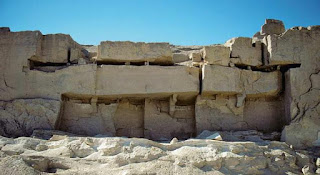A number of variations of the Old Kingdom titles "Master of the Roads" and "Official of the Masters of the Roads" have been found both in the Memphite necropolis and in the mining areas of the Wadi Hammamat and Wadi Abbad (in the Eastern Desert), suggesting that the coordination and maintenance of land routes through the desert was a high priority for the Egyptian administration. Many archaeological traces of specially constructed roads have been found in the areas surrounding mines, quarries, and major structures.
In the case of mineral resources exploited regularly for long periods, considerable amounts of time and energy were spent on the building of roads, the nature of each route being determined primarily by such factors as the bulk and quantities of the minerals, the nature of the topography, and the materials locally available for road-building. Thus the Old Kingdom quarries at Hatnub are linked with the Nile Valley by a drystone causeway extending for some 17 kilometers (11 miles), two small stretches of which are built up to a height of several meters, to allow stone blocks to be dragged across deep wadis. A paved road employing slabs of sandstone and fossil (petrified) wood conects the Gebel Qatrani basalt quarries with the site of Qasr el-Sagha at the northern end of the Faiyum region, covering a distance of about 10 kilometers (6 miles).
The longest known Egyptian quarry road is an 80-kilometer (50-mile) route in Lower Nubia, linking the diorite-gabbro and anorthosite gneiss quarries of the Old and Middle Kingdoms, near Gebel el-Asr, with the closest Nile embarkation point (at the former Tushka, now because of the new Aswan High Dam, covered by Lake Nasser). In the 1930s, Reginald Engelbach undertook a detailed examination of the ancient road, which was not a built structure (like the roads to Hatnub and Gebel Qatrani) but instead appears to have been simply a cleared track through the desert, with occasional scatters of stone or pottery. An important indication of the degree to which ancient Egyptians planned and organized their quarrying and mining expeditions has survived in the form of the Turin Mining Papyrus. This document—the earliest surviving Egyptian map—is an annotated record of an expedition to the mines and quarries of the Wadi Hammamat in the Eastern Desert in the mid-twelfth century BCE. The area depicted in the map has been identified with the archaeological site at Bir Umm Fawakhir, where there are still extensive remains of a Byzantine gold-mining settlement.
Recent Pages:
 |
| Drawing of the transportion scene of the colossu |
The longest known Egyptian quarry road is an 80-kilometer (50-mile) route in Lower Nubia, linking the diorite-gabbro and anorthosite gneiss quarries of the Old and Middle Kingdoms, near Gebel el-Asr, with the closest Nile embarkation point (at the former Tushka, now because of the new Aswan High Dam, covered by Lake Nasser). In the 1930s, Reginald Engelbach undertook a detailed examination of the ancient road, which was not a built structure (like the roads to Hatnub and Gebel Qatrani) but instead appears to have been simply a cleared track through the desert, with occasional scatters of stone or pottery. An important indication of the degree to which ancient Egyptians planned and organized their quarrying and mining expeditions has survived in the form of the Turin Mining Papyrus. This document—the earliest surviving Egyptian map—is an annotated record of an expedition to the mines and quarries of the Wadi Hammamat in the Eastern Desert in the mid-twelfth century BCE. The area depicted in the map has been identified with the archaeological site at Bir Umm Fawakhir, where there are still extensive remains of a Byzantine gold-mining settlement.
Recent Pages:





